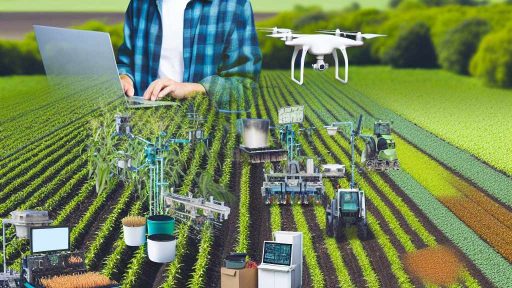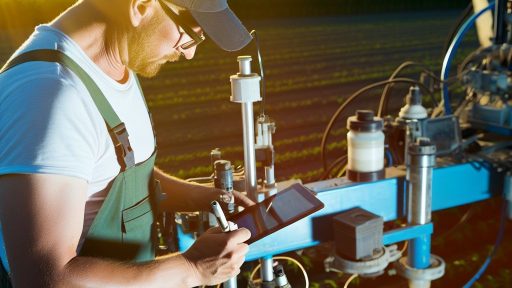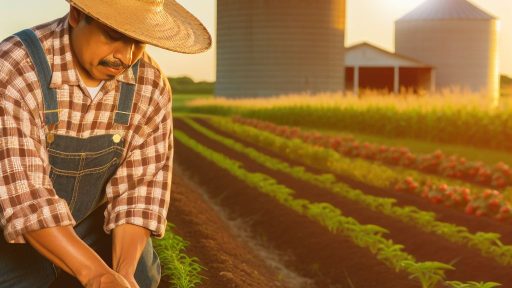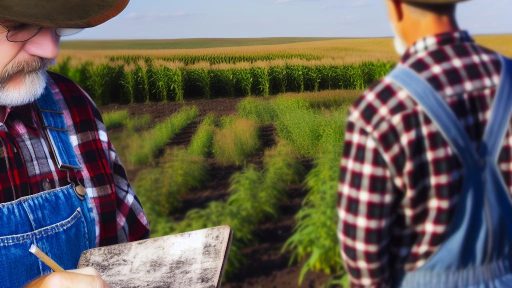Introduction to Farm Insurance
Farm insurance plays a crucial role in safeguarding agricultural operations.
Understanding its importance can lead to improved financial stability.
Farmers face unique risks that require specialized insurance coverage.
These risks include natural disasters, crop failures, and livestock illnesses.
As a result, farm insurance helps mitigate financial losses in uncertain times.
Moreover, it provides peace of mind for farmers and business owners.
With the right policy, farmers can focus on their operations confidently.
Farm insurance is not just a safety net; it is a strategic asset.
Types of Farm Insurance
Various types of farm insurance exist to meet different needs.
Crop insurance protects against the loss of crops due to adverse weather.
Livestock insurance covers losses related to animal health and accidents.
Farm property insurance protects buildings and equipment from damage.
Liability insurance shields against claims from third parties.
Additionally, multi-peril crop insurance combines several protections into one policy.
The Importance of Risk Assessment
Conducting a thorough risk assessment is essential for farmers.
Transform Your Agribusiness
Unlock your farm's potential with expert advice tailored to your needs. Get actionable steps that drive real results.
Get StartedThis process identifies potential vulnerabilities in farm operations.
By understanding their unique risks, farmers can choose appropriate coverage.
Moreover, regular assessments should occur to adapt to changing conditions.
Farmers can reduce premiums by implementing risk management practices.
Choosing the Right Insurance Provider
Selecting a reliable insurance provider is critical for success.
Farmers should research various companies and their offerings.
It is essential to consider the provider’s reputation and claims process.
Furthermore, customer service and support should influence the decision.
Farmers often benefit from working with agents who specialize in agriculture.
Common Misconceptions About Farm Insurance
Many misconceptions surround farm insurance that can lead to confusion.
Some believe that all policies are the same, which is not true.
Every farm’s needs differ, necessitating tailored coverage.
Another common myth is that insurance is too expensive for small farms.
In reality, policies can be customized to fit various budgets.
Lastly, some farmers think they don’t need insurance if they have few assets.
This is a risky mindset, as accidents can lead to significant financial losses.
Types of Farm Insurance Policies
Understanding Farm Insurance
Farm insurance provides essential coverage for agricultural operations.
Farmers can protect their investments and ensure financial stability.
Choosing the right policy is crucial for mitigating risks.
Property Insurance
Property insurance is one of the most common types of farm insurance.
This coverage protects physical assets, such as buildings and machinery.
For instance, it covers barns, silos, and equipment from damage.
Weather-related incidents, like storms and floods, can be insured.
Additionally, property insurance may cover fire and theft.
Showcase Your Farming Business
Publish your professional farming services profile on our blog for a one-time fee of $200 and reach a dedicated audience of farmers and agribusiness owners.
Publish Your ProfileLiability Insurance
Liability insurance protects farmers from legal claims and lawsuits.
This is essential for safeguarding personal and business assets.
General liability covers injury and property damage to third parties.
Product liability is crucial if you sell food items or produce.
Farmers must ensure adequate coverage against potential lawsuits.
Crop Insurance
Crop insurance covers losses from various risks to crops.
This includes natural disasters and adverse weather conditions.
Farmers can choose between multiple coverage options.
For example, Revenue Protection insures against income loss.
Moreover, Crop-Hail coverage specifically protects against hail damage.
Livestock Insurance
Livestock insurance safeguards the farmer’s investment in animals.
This includes coverage for death, theft, and certain health issues.
Policies are available for various types of livestock, including cattle and poultry.
Farmers should assess their needs and choose relevant coverage.
Specialized Insurance
Some farm operations require specialized insurance types.
This could include insurance for equipment breakdowns and pollution liability.
Farm-to-table operations may need unique policies as well.
Farmers should consult with industry experts for tailored options.
Choosing the Right Insurance
Selecting the right insurance policy requires careful thought.
Farmers should evaluate their specific needs and risks.
Consulting with an insurance agent can provide valuable insights.
Moreover, reviewing policies annually ensures adequate protection.
Farmers must remain informed about changes in coverage options.
Assessing Farm Risks
Understanding Farm Operations
Farm operations vary significantly from one location to another.
Your specific farming activities determine your unique risks.
For instance, crop farming involves different risks than livestock farming.
For example, a dairy farm faces different challenges than a grain farm.
Environmental Factors
The environment plays a critical role in farm risk assessment.
Weather patterns can change dramatically and impact crop yields.
Natural disasters such as floods and droughts can devastate operations.
Moreover, soil quality and pest populations also impact farming risks.
Market Conditions
Market fluctuations affect the financial stability of farms.
Prices for crops and livestock can vary widely based on demand.
Additionally, global economic trends influence local agricultural markets.
Therefore, understanding market forces is essential for risk assessment.
Regulatory Environment
Regulations can significantly impact farming operations.
Compliance with local, state, and federal laws is mandatory.
These laws may govern everything from land use to pesticide application.
Consequently, staying informed about regulatory changes is crucial.
Financial Considerations
Financial health plays a significant role in risk management.
Showcase Your Farming Business
Publish your professional farming services profile on our blog for a one-time fee of $200 and reach a dedicated audience of farmers and agribusiness owners.
Publish Your ProfileAssess your farm’s debt levels and cash flow situation regularly.
Furthermore, farm insurance options vary based on financial status.
Understanding your financial position helps identify needed coverage.
Insurance Coverage Options
Choosing the right insurance is critical for risk mitigation.
Consider various types of insurance, including crop and liability insurance.
Each type of coverage addresses different risks and exposures.
Moreover, regular policy reviews ensure adequate protection against risks.
Explore Further: Utilizing Technology to Support Farm Diversification
How Premiums are Calculated
Understanding Costs
Farm insurance premiums are influenced by various costs.
The type of coverage directly affects premium rates.
For example, property coverage may differ from liability coverage.
Moreover, the size of the farm plays a critical role.
Large farms often incur higher premiums due to increased risk.
The location of the farm also impacts cost calculations.
Areas prone to natural disasters typically have higher premiums.
Insurance companies evaluate soil quality and crop type as well.
Evaluating Coverage Options
Selecting the appropriate coverage is essential for accurate premium calculation.
Available options include crop insurance, livestock coverage, and property insurance.
Each type provides unique benefits and comes with specific terms.
It’s crucial to assess the risks associated with each option.
Farmers must consider their individual needs when choosing coverage.
Additionally, bundling different insurance types can result in discounts.
Factors Influencing Premium Rates
Insurance companies consider various factors when determining rates.
The farm’s operational history plays a significant role.
For instance, claims history can raise or lower premium costs.
Farmers with fewer claims may benefit from lower rates.
On the other hand, consistent claims can increase costs significantly.
Furthermore, the health of the business and market conditions are evaluated.
Market volatility may lead to adjustments in premium rates.
Utilizing Risk Management Strategies
Implementing risk management strategies can minimize insurance costs.
Farmers should stay informed about best practices in their operations.
Maintaining equipment and infrastructure reduces the likelihood of claims.
Additionally, participating in risk management programs may offer savings.
Collaborating with local agricultural extension offices can provide valuable insights.
Hence, proactive measures enhance financial stability in farming.
Delve into the Subject: Efficient Irrigation Methods To Reduce Farming Costs
The Claims Process: Step-by-Step Guide for Farmers
Introduction to the Claims Process
Understanding the claims process is essential for farmers.
This process ensures that farmers receive the financial support they need.
Following the correct steps makes filing easier and more efficient.
Assessing the Situation
The first step is to assess the situation promptly.
Showcase Your Farming Business
Publish your professional farming services profile on our blog for a one-time fee of $200 and reach a dedicated audience of farmers and agribusiness owners.
Publish Your ProfileIdentify the type of damage or loss on your farm.
This may include damages to crops, property, or livestock.
Take detailed notes and photographs for documentation.
Contacting Your Insurance Provider
Once you assess the damage, contact your insurance provider.
Inform them of the loss as soon as possible.
Provide them with all relevant information you collected.
This information helps expedite the claims process.
Filing the Claim
Next, you will need to file a formal claim.
Obtain the claim form from your insurance provider’s website.
Complete the form accurately and thoroughly.
Ensure you include all supporting documents.
Submission and Acknowledgment
After completing the form, submit it to your insurance company.
Most companies allow digital submission for convenience.
Upon receipt, they should acknowledge your claim promptly.
Claims Investigation
Your insurance provider will investigate the claim.
An adjuster may visit your farm to assess the damage.
Be prepared to discuss the situation with them.
Provide any additional information they may require.
Receiving Compensation
Upon completion of the investigation, the insurer will process your claim.
If approved, compensation will be issued based on your policy.
This amount will help cover your losses and restore financial stability.
Follow-Up on the Claim
After receiving compensation, follow up with your insurer.
Ensure all aspects of the claim have been settled.
If you encounter issues, communicate directly with your adjuster.
Keeping good records throughout this process is vital.
Preparation for Future Claims
Once your claim is settled, prepare for any future claims.
Review your policy and update coverage if necessary.
Regularly evaluate your farm’s risks and exposures.
This proactive approach will save you time and stress later.
Find Out More: Enhancing Farm Efficiency Through Supply Chain Optimization

Common Exclusions in Farm Insurance: What to Watch Out For
Understanding Policy Exclusions
Farm insurance often includes specific exclusions that limit coverage.
Knowing these exclusions helps farmers avoid unexpected losses.
Consequently, reviewing policy details is essential for informed decisions.
Natural Disasters
Many farm insurance policies exclude certain natural disasters.
For example, flooding, earthquakes, and hurricanes might not be covered.
Farmers should consider additional coverage options for these disasters.
Negligence and Poor Maintenance
Insurance policies often exclude damages arising from negligence.
Poorly maintained equipment or facilities may lead to denied claims.
Regular maintenance is crucial to prevent such issues.
Specific Crop and Livestock Limitations
Insurers may exclude certain crops or livestock from coverage.
Showcase Your Farming Business
Publish your professional farming services profile on our blog for a one-time fee of $200 and reach a dedicated audience of farmers and agribusiness owners.
Publish Your ProfileBees, hemp, or specialty crops often face restrictions.
Understanding these limitations helps farmers manage risks better.
Acts of War and Terrorism
Most policies exclude damages caused by war or terrorism.
Farmers should assess their risk exposure concerning these situations.
Seeking supplemental insurance may be wise for additional protection.
Intentional Acts
Insurance clearly excludes coverage for intentional acts of damage.
Farmers should ensure all operations comply with the law.
Understanding this aspect is vital to maintaining coverage integrity.
Delve into the Subject: Budgeting Tips For Sustainable Farming Practices
Benefits of Farm Insurance for Financial Stability
Risk Management and Financial Protection
Farm insurance plays a crucial role in risk management.
It provides financial protection against unpredictable events.
These events may include natural disasters, accidents, and theft.
Consequently, farmers can avoid devastating losses.
This assurance allows farmers to focus on productive activities.
Case Study: The Williams Family Farm
The Williams Family Farm faced severe flooding last year.
This flooding damaged their crop yield significantly.
However, they had comprehensive farm insurance coverage.
The insurance covered repair costs and revenue losses.
As a result, the Williams family maintained their financial stability.
Preserving Livestock
Insurance also safeguards livestock against health issues.
Farmers can insure animals for various diseases or accidents.
For instance, the Jenkins Farm experienced an outbreak of illness.
Fortunately, their livestock insurance covered veterinary expenses.
Thus, the farm retained its livestock and avoided bankruptcy.
Enhancing Loan Opportunities
Having farm insurance improves access to loans.
Lenders see insured farmers as lower-risk borrowers.
This perception enables farmers to secure necessary funding.
Moreover, they can invest in equipment, seeds, and fertilizers.
Ultimately, this leads to increased production and income.
Case Study: Green Pastures Dairy Farm
Green Pastures Dairy Farm successfully expanded its operation.
The owners took out loans based on their farm insurance.
They used the funds to purchase new milking equipment.
This investment resulted in a 20% increase in milk production.
Consequently, their revenue significantly increased, achieving financial growth.
Peace of Mind
Farm insurance provides peace of mind to farmers.
Knowing they are protected allows farmers to innovate.
This innovation can include diversifying crops and adopting new techniques.
As such, it fosters a more sustainable farming environment.
In the long run, peace of mind correlates with improved productivity.
Future of Farm Insurance
Trends in Farm Insurance
The landscape of farm insurance is changing rapidly.
Showcase Your Farming Business
Publish your professional farming services profile on our blog for a one-time fee of $200 and reach a dedicated audience of farmers and agribusiness owners.
Publish Your ProfileNew trends are emerging to meet modern agricultural needs.
For instance, crop diversification is becoming more popular.
Farmers are utilizing technology to better manage risks.
As a result, insurance companies are adapting their offerings.
Additionally, agritech innovations are streamlining processes.
Farmers increasingly rely on data analytics for decision-making.
Consequently, insurers must provide more customized solutions.
Innovations in Coverage
Innovative policies are being introduced to protect farmers.
Parametric insurance is gaining traction in the industry.
This type of coverage uses weather data to trigger payments.
Moreover, blockchain technology enhances transparency in transactions.
Farmers can secure coverage for specific risks more efficiently.
Insurance providers are also incorporating AI in risk assessment.
This automation helps streamline the underwriting process.
Challenges Facing the Industry
However, challenges persist within the farm insurance sector.
Climate change poses significant risks to agricultural production.
Insurers struggle to accurately assess these evolving risks.
Furthermore, there is a lack of awareness among farmers.
Many do not understand the various insurance options available.
Additionally, rising premiums may deter farmers from obtaining coverage.
Insurance companies must enhance their educational efforts.
Future Outlook
Looking ahead, the future of farm insurance appears promising.
As technology advances, farmers will have more options.
Insurance providers must remain flexible to adapt to changes.
Collaboration between farmers and insurers will be crucial.
Ultimately, this partnership can lead to more resilient agriculture.
Additional Resources
What is the Farm Bill? – National Sustainable Agriculture Coalition
Risk Management – Risk in Agriculture | Economic Research Service




